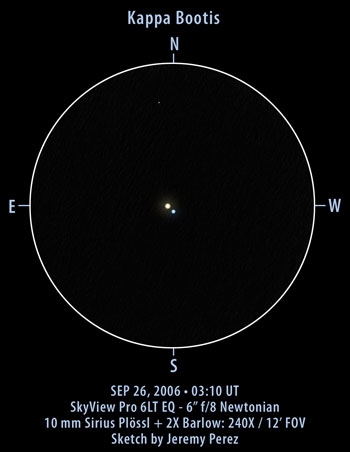
Observation Notes:
This was a subtle and uneven pair. The PA appeared to be 225° with a separation that was obout 1/36 of the 12 arc minute FOV–which works out to about 20 arc seconds. Actual values are 236° and 13.4 arc seconds.
The primary appeared pale yellow with a dull blue secondary. I became a bit frustrated when I was preparing the report for this observation because the primary of this pair is A7V with a F1V secondary. So if anything, I should have seen a light blue primary with a pale yellow primary or a version of that where one of the components was white. Instead I actually had the colors swapped. I decided to do some hunting to see what other observers saw. I found that quite a few that actually mentioned color noted the same swap that I did. Here are the links to those sites:
- Jeff Burton’s Astronomy Blog (White/Blue)
- Bootes Object List – Steve Coe (White/Light Blue)
- Astronomy Daily Forum – Trane Francks (White/Blue)
- Multiple Star List – Bill Anderson, et. al. (White/Blue)
- Constellation Observer Guide – Mark S. Baines (Gold/Blue)
- Canberra Astronomical Society – Ross Gould (Pale Yellowish-Green/Bluish Purple)
- AL Double Star Observating Log – M. Bracewell (Yellow/Bluish)
Search for “Kappa” at those links until you encounter Kappa BOO. These observers (as long as they are listing the primary first) are seeing a bluish secondary every time, and a white or yellow primary. This appears to be a pretty deceptively colored double. But not everyone was deceived:
Double and Multiple Stars and How to Observe Them by James Mullaney features a sketch by Sissy Haas that sports a white primary with a pale yellow secondary.
See also, Richard Bell’s Double Star Log, where he also sees a white primary with a secondary that has a hint of yellow.
One suggestion I came across in James Mullaney’s book is to stop down the aperture of the scope to 3 or 4 inches to see if that helps increase the strength of the star colors. I’ll be paying a visit to the fabric store to grab one of those embroidery circles to set up an aperture mask and give this a shot.
| Subject | Kappa Bootis (STF STF 1821) |
| Classification | Double Star |
| Position (J2000) | [RA: 14:13:27.8 / Dec: +51:47:16]* |
| Position Angle* | 236° (1973) |
| Separation* | 13.4″ (1973) |
| Magnitudes* | 4.54/6.69 |
| Spectral Types* | A7V / F1V |
| Date/Time | SEP 25, 2006 – 8:10 PM MST (SEP 26, 2006 – 03:10 UT) |
| Observing Loc. | Flagstaff, AZ – Home |
| Instrument | Orion SVP 6LT Reflector (150 mm dia./1200 mm F/L) |
| Eyepieces/Mag. | 10 mm + 2X Barlow (240X) |
| Conditions | Partly cloudy, calm |
| Seeing | 5/10 |
| Transparency | NELM Mag 5.8 |
| References | The Washington Visual Double Star Catalog, 1996.0 (Worley+, 1996) and Catalogue of Stellar Spectral Classifications (Skiff, 2005) via VizieR |
*Based on published data.
I observed Kappa Bootis with an 80mm refractor at 125X. I saw a pale blue primary. The first word that came to my mind to describe the secondary was “rust.” How many rusty stars have you seen?
That’s an interesting question–I looked through my notes and haven’t found a component that I described as rust colored so far. Although I have noted a few with a dull orange/reddish-orange that might fit the bill:
12 Lyncis (tertiary star)
83 Leonis (secondary)
AG 342 (secondary)
STF 1369 (tertiary)
STF 1521 (secondary)
Xi Bootis (secondary)
I’d have to keep that in mind the next time I have a look at those to see if ‘rust’ seems appropriate.
Thanks for the comment!